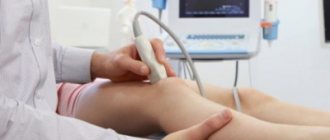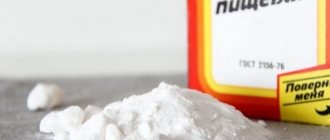Causes of crunching in joints
Causes of “crunching in the bones” - the so-called. crepitus - can be as follows:
- Congenital features of connective tissue. The elasticity of the ligaments and joint capsule is determined genetically. Some people have joint hypermobility - they say that they bend in all directions. If you can, for example, extend your arm at the elbow more than 180°, an anatomical feature may cause clicks in the joint. Another “hereditary” reason is insufficient production of joint lubrication.
- Gas bubbles. The viscous synovial fluid that lubricates the joint can form dioxide bubbles when pressure on the joint surfaces is suddenly released. You suddenly unloaded a limb, and when you took the next step you heard a pop in your knee? Don't worry, it's harmless.
- Tendon movement. When the joint flexes and extends, the tendon also shifts. It sometimes clicks into place when it clicks into place. Most often observed at the age of 10-19 years.
- Teenagers grow too fast. During adolescence, children grow in leaps and bounds, which is why the proportions of their body may be disrupted and their joints may not have time to “adjust.” In the absence of other pathologies, teenage cracking in the joints will go away on its own by the age of 16-24.
- Developmental anomalies. The articular surfaces may not coincide - the edges of the bones protruding from the articular capsule provoke a characteristic sound. Most abnormalities of the musculoskeletal system, which can cause crunching in the joints of the legs, are diagnosed by doctors in the first 7 years of a child’s life. For example, crunching when rotating the foot can cause flat feet.
- Hormonal and metabolic disorders. Age-related hormonal changes (male and female menopause), thyroid diseases and other factors of hormonal imbalance affect the elasticity of the joint. Also, crunching in the joints can be caused by uric acid deposits due to gout, arthropathy due to diabetes mellitus and other metabolic pathologies.
- Taking hormonal drugs. Oral contraceptives and drugs based on glucocorticosteroids can cause joint cracking. It disappears after completing the course or changing the drug.
- Injuries. If crunching and pain in the joints occurs after an injury or strenuous physical activity, you should consult a doctor. Sometimes the joint simply “dries out” due to a lack of synovial fluid, in which case it needs rest and supportive care for 2-3 weeks. And sometimes an already worn-out joint crunches - you need to rush to a rheumatologist to save it.
- Long immobility. For normal production of joint lubrication, the joint must experience moderate physical stress. With a sedentary lifestyle, the joint glides poorly and begins to crunch, and weakness of the ligamentous apparatus is observed. If the cause of joint immobility was an injury, you should consult a rehabilitation doctor who will help restore its functionality without consequences.
- Age-related changes and diseases. Among patients over 60 years of age, inflammatory or degenerative diseases in the joints and adjacent muscles are common. They are less commonly diagnosed in young people.
Excess weight, uncomfortable shoes, and an uncomfortable workplace can also cause crunching and pain in the joints due to improper load distribution.
How do you know when it's time to see a doctor?
In itself, crunching in the joints is not a pathology and is even reassuring - with advanced joint diseases it is physiologically impossible.
You need to be concerned about a cracking sound in a joint if it is accompanied by:
- a feeling of friction - as if sand had gotten between the heads of the bones;
- pain that intensifies with movement;
- unusual tension, twitching in the muscles even at rest;
- swelling of the joint and increase in its volume, engorged soft tissues;
- limitation of mobility in the joint;
- a feeling that the joint is “jammed” - possibly a foreign body in the joint capsule;
- redness of the skin over the joint, local increase in temperature;
- a feeling of numbness in the muscles, their weakness, up to impairment of gait or fine motor skills.
Healthy crackling occurs periodically. A simple example: if a gas bubble collapses in a joint, when you move again, there will be no more crunching noise, no matter how much you bend the limb. But the pathological one is heard constantly and only intensifies over time. The specificity of the sound also differs. A loud, dry crunch is quite normal. But if you hear something rough, “with a grinding sound,” check with your doctor for the causes and treatment of crunching in the joints.
General symptoms of injuries
Depending on the type of damage, it may be accompanied by various symptoms. The most common are the following:
- Severe swelling;
- Decreased mobility, blocking of a number of movements;
- Crunching, clicking, extraneous sounds;
- Deformation of bone tissue;
- Increased temperature in the kneecap area;
- Inability to lift a heavy object;
- Acute pain;
- Constant aching pain;
- Decreased sensitivity.
In which joints is the crunch heard?
Almost all joints can crackle - from the temporomandibular joints to the interphalangeal joints and even the intervertebral joints. For some joints, dry crunching is a physiological norm due to their active load and specific axis of rotation. Therefore, you should not worry about how to get rid of crunching in the joints if “healthy” crackling is heard in the ankles, knees, fingers and spine.
Crunching in the hip joint
Crunching in the hip joint is common among athletes, dancers, and people involved in physical labor. It is often caused by the so-called. snapping hip syndrome - a sound that occurs when tendons roll over bones as the joint flexes and extends.
The hip joint can crunch when there is excess protein in the diet or dehydration. Increasing crunching and pain in the joints may indicate the development of arthritis or arthrosis of the hip joints, or other inflammatory diseases in the muscles and ligaments.
Crunching in the knee joint
Crunching in the knees usually occurs as a result of stress, changes in the periarticular tissues (muscles, ligaments, tendons). Frequent squats, sitting too low or too high, and the habit of tucking your legs can interfere with blood circulation and cause congestion, which is accompanied by a crunch in the knee joint. They are not a pathology, although they can contribute to cartilage degeneration.
Actually, the destruction of the knee joint is accompanied by swelling, discomfort when moving, pain when squatting and other loads.
Crunch in the shoulder joint
Clicking and crunching sounds in the shoulder joint are rarely observed when the joint capsule and soft tissues are healthy. In patients under 35 years of age, they usually occur due to injury—usually while attempting to bench press at the gym. With proper treatment, crunching and other symptoms disappear within 2-4 months. Arthritis of the shoulder joint is more common among people over 60 years of age.
Crunching in fingers
The joints of the fingers are the “crispiest” in the human body. The articular surfaces of the fingers move away from each other more often than others, forming gas bubbles, and ligaments and tendons (there are especially many of them in the hands) more often rub against the protrusions of the bones. How to remove crunching in hand joints? No way. This is an absolutely normal phenomenon - a tribute to developed fine motor skills.
But if your fingers bend worse and become swollen, it’s time to see a doctor.
Structures that can provoke a pathological condition
As a rule, the knees click when a hard structure in the joint is damaged, although a similar condition can also be caused by disturbances in the area of the articular surfaces when soft tissues are involved in the pathological process.
Most often, the appearance of a crunch in the knee area is associated with damage to the following structures:
- patella;
- distal femur;
- proximal tibia;
- menisci;
- articular cartilage;
- joint capsules.
Structures that make up the knee joint
The appearance of a crunch can be caused by damage to one or simultaneous involvement of several structures in the pathological process. Therefore, it is important to know the cause of this condition and what to do if this condition does not go away for a long time.
How to treat cracking joints
The choice of treatment begins with a diagnosis by a rheumatologist. To do this, you need to undergo an initial examination, functional tests, and possibly x-ray and laboratory tests. If crunching in the joints appears after an injury, it is better to consult a traumatologist.
The first step to treating cracking joints is making a diagnosis.
Treatment for cracking joints is aimed at:
- stopping the inflammatory process in the joint or soft tissues,
- elimination of primary diseases or other causes that caused a problem with the joint (damage to ligaments, cartilage, menisci, labrum, etc.),
- maintaining the elasticity of cartilage,
- prevention of further joint destruction.
Preparations for cracking joints
If the patient is concerned about pain and symptoms of inflammation, non-steroidal anti-inflammatory drugs for cracking joints - such as diclofenac, meloxicam, nimesulide, ibuprofen, naproxen, indomethacin, ketoprofen - become the standard choice. In severe cases, steroids (glucocorticoids) are used - prednisolone, methotrexate and others. The dosage and procedure for using hormonal tablets for cracking joints should be determined by a doctor!
Preparations for cracking joints based on chondroitin and glucosamine (the main structural components of cartilage) are recommended in all cases without exception - as prevention and maintenance therapy of degenerative processes. These include chondroprotectors artracam, artradol, dona, structum (they are available in the form of tablets for cracking joints, which need to be taken for 3-6 months).
If drug treatment for cracking joints is ineffective, the question of partial or complete joint replacement may arise.
Physiotherapy
Physiotherapy is used both in the acute phase of the disease and during remission. It allows you to relieve inflammation, deliver medications to tissues, reduce pain and improve mobility in the joints. Physiotherapeutic methods for treating crunching joints improve blood supply to the muscles and connective tissue around the joint (which means the cartilage receives more nutrients) and restore healthy metabolism. Particularly effective for cracking joints has been demonstrated by:
- kinesiotherapy;
- physiotherapy;
- massage;
- magnetic wave therapy;
- medicinal electrophoresis;
- UHF;
- amplipulse
Other treatments
To treat cracking joints, it is important to include a special diet that helps balance the water-salt balance, nourish cartilage tissue and reduce body weight if you are overweight. The specifics of the diet depend on the causes of the crunch: for diabetes, the consumption of carbohydrates is minimized, for gout - meat.
You should not ignore a rehabilitation doctor - he will help you choose the optimal level and type of physical activity (therapeutic exercises, walking, swimming, cycling, modeling), comfortable orthoses and other ergonomic devices.
Conservative treatment of injuries
If we are talking about a minor injury, they resort to conservative treatment methods. First of all, this:
- Therapeutic gymnastics , performing various types of exercises under the guidance of a specialist for the allotted time (as a rule, this is a whole course of exercise therapy - there is no effect from one lesson);
- Physiotherapeutic measures - magnetic therapy, ultrasound, kinesio taping, exercises on special simulators;
- Taking medications.
The doctor will determine which medications will be prescribed and which physiotherapeutic procedures will be used – he will prescribe treatment depending on the severity of the injury and the characteristics of the individual patient’s body.
Doctors' advice: how to get rid of crunching in joints?
To prevent and treat crunching in the joints, doctors recommend alternating physical activity with rest, not allowing the joint fluid to stagnate. Also get rid of bad habits - alcohol, smoking and excess coffee consumption accelerate the destruction of joints and reduce the effectiveness of treatment for cracking joints.
Physical activity
Avoid both inactivity and heavy loads on the joint. Any sports exercise should begin with a warm-up, which will “warm up” the muscles and prevent starvation of the cartilage. Aggressive sports, running, and strength training with cracking joints are contraindicated, especially if you have been diagnosed with inflammatory, degenerative changes, or joint hypermobility.
If the crunch in the joints is not associated with the individual anatomical characteristics of the patient, doctors recommend walking more (at least 40-60 minutes or 10 thousand steps a day, or 5-8 km) or cycling, swimming (2-3 times a week ), do Nordic walking or yoga. To track your activity, install a pedometer on your phone. Exercise should be done daily and systematically - do not try to catch up in a few hours 2 times a week. This can worsen the condition of the joint, because synovial fluid does not have time to be produced during intense exercise.
For arthritis and arthrosis, it is better to do not standard exercises, but a set of general strengthening exercises that help maintain the tone of muscles and ligaments.
Labor activity
Increased joint mobility, although not a pathology, can cause varicose veins or injuries due to high load on the joints. Taking this feature into account, it is better not to choose standing work. If you still have to stand, shift your weight from foot to foot more often, equip the place with a low bench on which you can place your foot from time to time. To prevent crunching in the joints, try to dilute the work in the same position with 10-15 minute warm-ups (3-4 during the day) - so-called. industrial gymnastics exercises. These include rotation of the head and torso, clenching and unclenching of fists, circular movements of the feet, hands, knees, and the “mill” exercise with the hands.
If necessary, use elastic bandages and restraints while working.
Weight
Regardless of the causes and treatment of cracking in the joints prescribed by the doctor, the patient needs to lose excess weight - it disrupts the healthy distribution of load between the joints, which is why the intervertebral discs of the lumbar region, hip, knee, and ankle joints begin to suffer. For example, 1 extra kilogram of weight is felt by the knee cartilage as 5.









